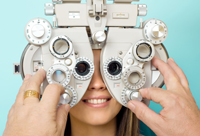 The Need for Glasses and Contacts
The Need for Glasses and Contacts
Over 140 million people in the U.S. wear eyeglasses, and over 30 million wear contact lenses. Glasses and contact lenses improve vision by adjusting the way the eyes bend and focus light. Ideally, the cornea refracts (bends) light rays as they enter the eye so that they focus on the retina in the back of the eye. However, many people’s corneas have a shallow or steep curvature which causes light rays to focus in front of or behind the retina. Objects may then appear blurry at certain distances or at all distances. Complete eye exams allow doctors to prescribe the right contacts or glasses for their patients.
Glasses and contact lenses correct these refractive errors. Eye doctors measure prescriptions for each eye so patients can enjoy optimal vision clarity.
Complete Eye Exams
Regular eye exams test for the development and progression of refractive errors and help your eye doctor provide a proper prescription if eyeglasses or contact lenses are needed.
Regular eye exams are an invaluable tool in maintaining your eyes’ health by detecting and preventing disease. Some diseases develop slowly without causing pain or vision loss. Early detection of any problems can reduce the risk of further harm and allow for a choice of treatment options.
